the 2007 Abstract Presentations - Wound Healing Society
the 2007 Abstract Presentations - Wound Healing Society
the 2007 Abstract Presentations - Wound Healing Society
You also want an ePaper? Increase the reach of your titles
YUMPU automatically turns print PDFs into web optimized ePapers that Google loves.
<strong>Abstract</strong>s<br />
126<br />
ELECTROSPUN FIBRINOGEN AND FIBRIN NANOFIBERS<br />
FOR ANGIOGENESIS IN VITRO<br />
Tatjana Morton 1 , Lila Nikkola 2 , Nurredin Ashammakhi 2 , Susanne Wolbank 3 ,<br />
Anja Peterbauer 1 , Martijn van Griensven 1 , Heinz Redl 1<br />
1 Ludwig Boltzmann Institute for Experimental and Clinical Traumatology,<br />
Vienna, Austria,<br />
2 Tampere University of Technology, Institut of Biomaterials, Tampere,<br />
Finland,<br />
3 Red Cross Blood Transfusion Service of Upper, Linz, Austria<br />
Introduction: Electrospinning has been recognized as an efficient technique for<br />
<strong>the</strong> fabrication of polymer nanofibers. It uses an electric field to control <strong>the</strong><br />
deposition of polymer fibers onto a target substrate. This electrostatic processing<br />
strategy can be used to fabricate fibrous polymer mats composed of fiber<br />
diameter mostly between 100 nm and 3 mm. In this study, we describe electrospinning<br />
of fibrinogen and fibrin nanofibers in an attempt to create biomimicking<br />
tissue-like material in vitro for use as a tissue scaffold for angiogenesis.<br />
Materials and Methods: We have used lyophilized human fibrinogen of <strong>the</strong><br />
product Tisseel s VH (Baxter AG, Austria) to demonstrate fibrinogen and<br />
fibrin electrospinning. Fibrinogen dissolved in 1,1,1,3,3,3-hexafluoro-2-propanol<br />
and sodium chloride solution was electrospun under various conditions. To<br />
create fibrin nanofibers a mixture of solved fibrinogen and thrombin was spun.<br />
The quality of electrospun fibers were analyzed by scanning electron microscopy<br />
(SEM) and gelelectrophoresis. For in vitro tests sterile matrices were<br />
seeded with human adipose derived stem cells cultured in DMEM/Ham’s F-12<br />
medium for 14 days.<br />
Results and Discussion: Electrospun fibers of fibrionogen and fibrin were<br />
processed for scanning electron microscopy (SEM) evaluation and analyzed<br />
by native gelelectrophoresis. Because of <strong>the</strong>ir small diameters, fibers are more<br />
attractive for cell attachment. Their similarity in size to native extracellular<br />
matrix components and <strong>the</strong> 3-dimensional structure allows cells to attach to<br />
several fibers in a more natural geometry. In addition seeded cells showed<br />
different proliferation patterns on matrices containing growth factors in<br />
comparison on nanofibers without additives. From <strong>the</strong> results of this study we<br />
think that it may be possible to construct fibrous scaffoldings composed of<br />
nanofibers for tissue engineering and wound repair using <strong>the</strong> process of<br />
electrospinning with fibrinogen or fibrin. With <strong>the</strong> electrospinning process,<br />
structures of various shapes and sizes can be constructed to get 3-dimensional<br />
appropriate scaffolds for specific use.<br />
127<br />
AN EVALUATION OF HYPEROXYGENATED FATTY ACID<br />
(HOFA) AND ITS EFFECTS ON THE MICROCIRCULATORY<br />
AND BARRIER PROPERTIES OF THE SKIN<br />
F. Muniz, D. Brett<br />
Smith & Nephew <strong>Wound</strong> Management Division, Largo, FL, USA<br />
Introduction: HOFA is a technology based on <strong>the</strong> introduction or saturation of<br />
peroxides into fatty acid esters via <strong>the</strong> presence of ultraviolet light and<br />
controlled temperatures. During <strong>the</strong> manufacturing process, oxygen is introduced<br />
by bubbling oxygen through natural oils at a specific temperature over<br />
time until <strong>the</strong> oil viscosity increases and <strong>the</strong> peroxide value is achieved. The use<br />
of this product has been adopted as a method of preventing pressure ulcers and<br />
treating circulatory insufficiencies. It is felt that this <strong>the</strong>rapy is effective due to<br />
<strong>the</strong> release of free oxygen thus promoting microcirculation at <strong>the</strong> site of<br />
application. Improvements in local microcirculation, barrier properties, elasticity,<br />
moisturization levels, etc., of <strong>the</strong> skin have provided clinical evidence to <strong>the</strong><br />
efficacy of HOFA.<br />
Methods: Microcirculation evaluated via Laser Doppler, Transepidermal<br />
Water Loss (TEWL) evaluated via Servo Med EP2 Evaporimeter and Moisturization<br />
Value evaluated via Nova DPM 9003.<br />
Results: Microcirculation –an increase of 28% microcirculation was achieved<br />
after application of HOFA to skin. Transepidermal Water Loss (TEWL) - a<br />
reduction of <strong>the</strong> TEWL was achieved after application of HOFA to skin.<br />
Moisturization Value- an increase in <strong>the</strong> level of moisturization was achieved<br />
after application HOFA to skin. Note: all data were generated against a control<br />
of no HOFA treatment.<br />
Discussion: Based upon a preliminary evaluation of <strong>the</strong> HOFA technology/<br />
<strong>the</strong>rapy, data shows evidence of a physical response to <strong>the</strong> application of<br />
HOFA to <strong>the</strong> skin. As a result, an increase in microcirculation, moisturization<br />
and a reduction of TEWL were noticed after application. This investigation<br />
opens opportunities to fur<strong>the</strong>r study <strong>the</strong> benefit of this technology/<strong>the</strong>rapy as a<br />
potential pressure ulcer prevention <strong>the</strong>rapy as well as a <strong>the</strong>rapy to improve <strong>the</strong><br />
barrier properties of <strong>the</strong> skin.<br />
128<br />
ULTRASTRUCTURAL LOCALIZATION OF INTEGRIN<br />
SUBUNIT BETA 4 AND ALPHA 3 WITHIN THE MIGRATING<br />
EPITHELIAL TONGUE OF IN VIVO HUMAN WOUNDS<br />
Robert A. Underwood 1 , Marcia L. Usui 1 , William G. Carter 2,3 , John E.<br />
Olerud 1<br />
1 Department of Medicine (Dermatology), University of Washington, Seattle<br />
WA, USA,<br />
2 Department of Pathology, University of Washington, Seattle WA, USA,<br />
3 Fred Hutchinson Cancer Research Center, Seattle WA, USA<br />
Subsequent to wounding, keratinocytes must quickly restore barrier function.<br />
In vitro wound models have served to elucidate many cellular mechanisms of<br />
wound closure. To evaluate <strong>the</strong> roles of associated integrins alpha 6 beta 4 and<br />
alpha 3 beta 1 in vivo, we used ultrathin cryomicrotomy to concomitantly<br />
observe tissue ultrastructure and immunogold localization in unwounded skin<br />
in 1 to 2 day human cutaneous wounds. Localization of <strong>the</strong> beta 4 integrin<br />
subunit in unwounded skin shows expected dominant hemidesmosomal association<br />
and minor lateral basal cell-cell expression. Beta 4 in <strong>the</strong> migrating<br />
epi<strong>the</strong>lial tongue localized to both lamellipodia and filopodia in juxtaposition<br />
to wound matrix. Increased concentrations of beta 4 were found in cytoplasmic<br />
vesicles within a subset of leading edge keratinocytes. The alpha 3 integrin<br />
subunit showed strong association with filopodia but not lamellipodia, and was<br />
dominantly localized to basal lateral cell-cell junctions in unwounded skin and<br />
both cell-cell and cell-matrix interactions in wounded skin. In vivo ultrastructural<br />
localization of integrin subunits beta 4 and alpha 3 supports <strong>the</strong><br />
hypo<strong>the</strong>sis, based on in vitro studies, that beta 4 has a multifunctional<br />
involvement in stable adhesion and transient adhesion within actin rich<br />
lamellipodia and filopodia and may follow a different endosomal trafficking<br />
pathway than <strong>the</strong> alpha 3 integrin subunit. George F. Odland Endowed<br />
Research Fund, NIH DK 59221, NIH EB 004422, NSF EEC 9529161<br />
[University of Washington Egineered Biomaterials (UWEB)].<br />
129<br />
CXCR3 / MICE DISPLAY A DYSFUNCTION IN<br />
BASEMENT MEMBRANE REMODELING AND DELAY IN<br />
RE-EPITHELIALIZATION DURING WOUND HEALING.<br />
Diana Whaley, Cecelia C. Yates, Wayne W. Hancock, Bao Lu, Joseph<br />
Newsome, Patricia A. Hebda, Alan Wells<br />
Department of Pathology and Otolaryngology, University of Pittsburgh and<br />
Pittsburgh VAMC<br />
<strong>Wound</strong> healing results from a complex and dynamic series of biological events<br />
that require several growth factors, chemokines and matrix components to<br />
signal in a synchronize manner. We have found that this process is at least in<br />
part mediated by ELR-negative chemokines acting through <strong>the</strong> common<br />
receptor CXCR3. We have previously shown that in <strong>the</strong> absence of CXCR3<br />
signaling, full thickness excisional wounds exhibited a significant delay in<br />
dermal healing, poor remodeling, and diminished reorganization of collagen<br />
that impacted <strong>the</strong> dermal strength. However, <strong>the</strong> status of dermal maturation<br />
communicates with epidermal healing.<br />
To examine CXCR3 role in re-epi<strong>the</strong>lialization and <strong>the</strong> re-establishment of <strong>the</strong><br />
dividing basement membrane in wound repair, full thickness excisional wounds<br />
were created on CXCR3 wild type (1/1) and knockout ( / ) mice. <strong>Wound</strong>s<br />
were histologically analyzed for re-epi<strong>the</strong>lialization at various days postwounding.<br />
Production of extracellular matrix components such as laminin, Type IV<br />
collagen, fibronectin, and tenascin, involved in formation of basement membrane,<br />
was analyzed immunohistochemically at days 7, 14, 21, 30, 60, and 90<br />
postwounding. We have demonstrated that <strong>the</strong> loss of CXCR3 signal not only<br />
results in a delay in <strong>the</strong> re-epi<strong>the</strong>lialization process but an altered expression of<br />
many key basement membrane components implicated in wound repair. These<br />
results suggest that CXCR3 and its ligands may play an important role in<br />
directing <strong>the</strong> reconstruction of <strong>the</strong> basement membrane and modulates reepi<strong>the</strong>lialization.<br />
These studies fur<strong>the</strong>r establish <strong>the</strong> emerging signaling network<br />
that involves <strong>the</strong> CXCR3 chemokine receptor and it ligands as a major<br />
regulator of wound repair.<br />
These studies were supported by grants from <strong>the</strong> National Institute of General<br />
Medical Science of <strong>the</strong> National Institutes of Health (USA).<br />
A48<br />
<strong>Wound</strong> Rep Reg (<strong>2007</strong>) 15 A14–A54 c <strong>2007</strong> by <strong>the</strong> <strong>Wound</strong> <strong>Healing</strong> <strong>Society</strong>


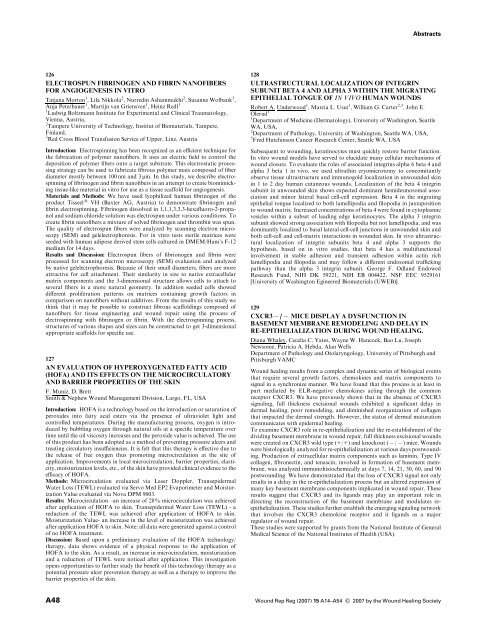

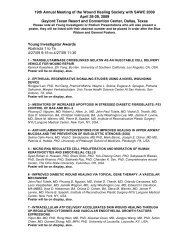

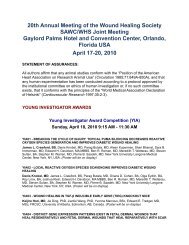
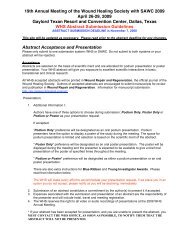
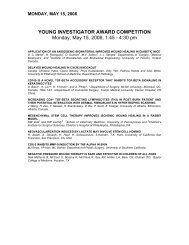



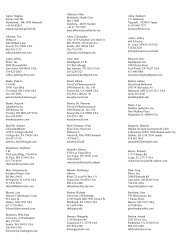
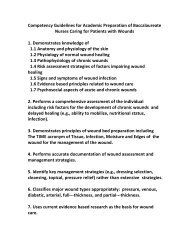
![2010 Abstracts-pah[2] - Wound Healing Society](https://img.yumpu.com/3748463/1/190x245/2010-abstracts-pah2-wound-healing-society.jpg?quality=85)